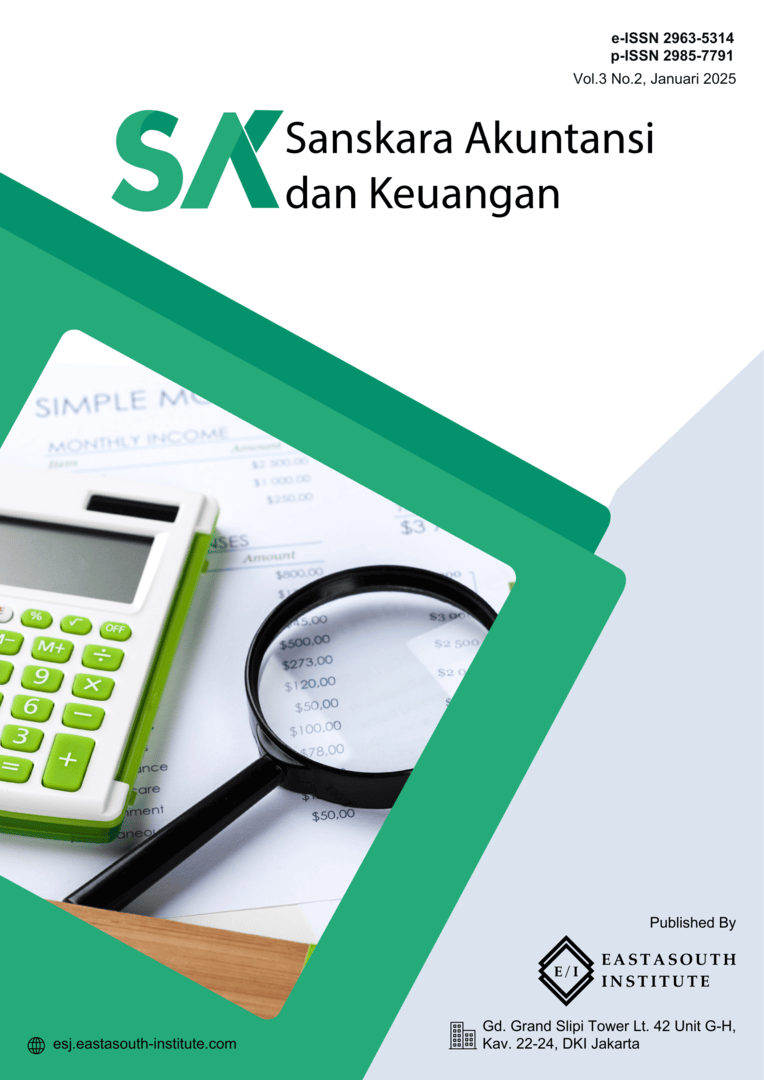Analisis Evolusi dan Tren Riset Green Audit Menggunakan Pendekatan Bibliometrik
Main Article Content
Abstract
Penelitian ini menganalisis evolusi dan tren penelitian Green Audit menggunakan pendekatan bibliometrik berbasis data publikasi internasional. Dengan memanfaatkan perangkat lunak VOSviewer, penelitian ini mengidentifikasi topik utama seperti keberlanjutan, efisiensi energi, dan mitigasi perubahan iklim yang mendominasi literatur Green Audit. Temuan menunjukkan peningkatan signifikan dalam jumlah publikasi, terutama setelah tahun 2020, yang mencerminkan perhatian global terhadap keberlanjutan lingkungan. Hasil analisis kolaborasi menunjukkan bahwa United Kingdom memiliki peran dominan dalam jaringan penelitian global. Meskipun terdapat tantangan seperti kurangnya harmonisasi standar dan keterbatasan sumber daya, penelitian ini menyoroti peluang melalui adopsi teknologi dan kolaborasi internasional untuk meningkatkan efektivitas Green Audit. Studi ini memberikan rekomendasi strategis bagi penelitian dan implementasi Green Audit di masa depan.
Article Details

This work is licensed under a Creative Commons Attribution-ShareAlike 4.0 International License.
References
Aria, M., & Cuccurullo, C. (2017a). A brief introduction to bibliometrix. Journal of Informetrics, 11(4), 959–975.
Aria, M., & Cuccurullo, C. (2017b). bibliometrix: An R-tool for comprehensive science mapping analysis. Journal of Informetrics, 11(4), 959–975.
Banu, D. A., Sheela, S., Muralimohan, N., Saranya, N., Kolar, A. B., & Santhya, V. (2023). Importance and Benefits of Green Audits to Education Institutions and Industrial Sectors. International Journal of Environment and Climate Change, 13(12), 349–356.
Berardi, U. (2016). The outdoor microclimate benefits and energy saving resulting from green roofs retrofits. Energy and Buildings, 121, 217–229.
Campbell, H. (2009). Breaking new ground in food regime theory: corporate environmentalism, ecological feedbacks and the ‘food from somewhere’regime? Agriculture and Human Values, 26, 309–319.
CHANDRA, B. K. (n.d.). Green Audit Report.
Fernando, Y., & Hor, W. L. (2017). Impacts of energy management practices on energy efficiency and carbon emissions reduction: a survey of Malaysian manufacturing firms. Resources, Conservation and Recycling, 126, 62–73.
Fuadah, N., Nurdian, T., Fadhilah, N. H. K., Riany, M., Bahri, N. A., & Rusdiansyah, N. (2023). Implementation of Operational Audits in an Effort to Improve the Efficiency and Effectiveness of the Marketing Function. Atlantis Press International BV. https://doi.org/10.2991/978-94-6463-226-2_20
Ganga, G. (2019). Green Audit for the Environmental Sustainability. In Green Public Procurement Strategies for Environmental Sustainability (pp. 45–58). IGI Global.
Gaston, K. J., Warren, P. H., Thompson, K., & Smith, R. M. (2005). Urban domestic gardens (IV): the extent of the resource and its associated features. Biodiversity & Conservation, 14, 3327–3349.
Gray, R., & Collison, D. (1991). The environmental audit: green‐gauge or whitewash? Managerial Auditing Journal, 6(5).
Hajek, P., & Henriques, R. (2017). Mining corporate annual reports for intelligent detection of financial statement fraud–A comparative study of machine learning methods. Knowledge-Based Systems, 128, 139–152.
Hansen, R., Olafsson, A. S., Van Der Jagt, A. P. N., Rall, E., & Pauleit, S. (2019). Planning multifunctional green infrastructure for compact cities: What is the state of practice? Ecological Indicators, 96, 99–110.
Loram, A., Tratalos, J., Warren, P. H., & Gaston, K. J. (2007). Urban domestic gardens (X): the extent & structure of the resource in five major cities. Landscape Ecology, 22, 601–615.
madu, D. hermawan, Fitriana, Santoso, R. A., & Rusdiansyah, N. (2024). Analisis Bibliometrik Tren Kolaborasi Penelitian antar Peneliti terkait dengan Audit Eksternal suatu Bisnis serta Instansi Pemerintah di Indonesia (Tahun 2018-2023). Jurnal Aktiva : Riset Akuntansi Dan Keuangan, 6(1 SE-Article). https://doi.org/10.52005/aktiva.v6i1.223
Mishra, S., Sharaff, R., & Sharma, R. (n.d.). 6. Green Audit: A Weapon to Reduce Environmental Pollution. Sustainable Environment Practices (SEP), 48.
Nazarova, K., Hotsuliak, V., Miniailo, V., Nezhyva, M., & Mysiuk, V. (2020). Accounting, analysis and environmental audit as an imperative of the development of green economy in the state’s economic security system. E3S Web of Conferences, 166, 13003.
Pradip, J. S., & Patil, P. D. (2014). Green Audit-a Tool for Attaining Sustainable Development & Achieving Competitive Advantage. IBMRD’s Journal of Management & Research, 3(1), 85–93.
Raju, C. R., Alivelu, M., Lingareddy, G., Karunakar, V., & Priyanka, S. (n.d.). A Green Audit of the Institution: A Step Towards Environmental Sustainability.
Rametsteiner, E., & Simula, M. (2003). Forest certification—an instrument to promote sustainable forest management? Journal of Environmental Management, 67(1), 87–98.
Rao, P. (2002). Greening the supply chain: a new initiative in South East Asia. International Journal of Operations & Production Management, 22(6), 632–655.
Sulakhe, P. P. (2018). Development of rating system for Green Audit. Rajarambapu Institute of Technology, Rajaramnagar.
Team, G. A. (2022). Green Audit Report. Vijaya College.
Tian, Y., & Pan, X. (2024). Green finance policy, financial risk, and audit quality: evidence from China. European Accounting Review, 33(2), 589–615.
Van Dillen, S. M. E., de Vries, S., Groenewegen, P. P., & Spreeuwenberg, P. (2012). Greenspace in urban neighbourhoods and residents’ health: adding quality to quantity. J Epidemiol Community Health, 66(6), e8–e8.
Van Eck, N. J., & Waltman, L. (2014). Visualizing bibliometric networks. In Measuring scholarly impact: Methods and practice (pp. 285–320). Springer.
Yadav, P. S., Goar, V. K., & Yadav, N. S. (2024). Significance Of Green Audit And Green Campus For Obtaining The Naac Accreditation. ShodhSamajik: Journal of Social Studies, 1(1), 23–34.

